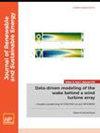A sustainable model using RSM and MCDM techniques to evaluate performance and emission characteristics of a diesel engine fueled with diphenylamine antioxidant and CeO2 nanoparticle additive biodiesel blends
IF 1.9
4区 工程技术
Q4 ENERGY & FUELS
引用次数: 0
Abstract
Overconsuming fossil fuels has worsened global warming and air pollution, requiring us to investigate alternate fuels for compression ignition engines. Biodiesel is a renewable fuel and environmentally favorable. Biodiesel's most significant disadvantage is increased nitrogen oxide (NOx) emissions. The intent of the present study was to examine the impact of antioxidant diphenylamine (DPA) and nanoparticle ceria (CeO2) additive inclusion in a B30 blend on engine performance and exhaust emission characteristics. For this study, diesel, Jatropha biodiesel (B30), 100 ppm of antioxidant diphenylamine (50 ppm) with ceria nanoparticle (50 ppm) is added to the B30 blend named as B30+DPA100 and antioxidant diphenylamine (50 ppm) with ceria nanoparticle (50 ppm) is added to the B30 blend named as B30+DPA50+CeO250 fuel blends has been used. A hybrid response surface methodology and multi-criteria decision-making techniques (entropy method, TOPSIS, and VIKOR) have been used to develop a sustainable model and find the optimal setting of input parameters in terms of ranking. From experimental findings, the inclusion of antioxidants (DPA) and nanoparticle (CeO2) at 50 ppm to B30 significantly reduced NOx emission. The brake-specific fuel consumption and NOx have been found reduced by 5.67% and 18.87%, respectively, for B30+DPA50+CeO250 as compared to B30. At the same time, brake thermal efficiency increased by 1.01%. The brake mean effective pressure and maximum cylinder pressure) have been found increased by 0.68% and reduced by 4.52%, respectively, for B30+DPA50+CeO250 as compared to B30. The alternative ranking of the input parameters has been found fuel injection pressure (300), compression ratio (17), and load (12) as Rank 1 for TOPSIS and VIKOR. Therefore, the B30+DPA50+CeO250 blend is appropriate for improving diesel engine performance and diminishing exhaust emissions.利用 RSM 和 MCDM 技术建立可持续模型,评估以二苯基胺抗氧化剂和 CeO2 纳米粒子添加剂混合生物柴油为燃料的柴油发动机的性能和排放特性
过度消耗化石燃料加剧了全球变暖和空气污染,这就要求我们研究用于压燃式发动机的替代燃料。生物柴油是一种可再生燃料,对环境有利。生物柴油最大的缺点是氮氧化物(NOx)排放量增加。本研究的目的是考察在 B30 混合燃料中加入抗氧化剂二苯胺(DPA)和纳米粒子铈(CeO2)添加剂对发动机性能和废气排放特性的影响。本研究使用了柴油、麻风树生物柴油(B30),在 B30 混合燃料中添加了 100 ppm 的抗氧化剂二苯胺(50 ppm)和纳米铈(50 ppm),命名为 B30+DPA100 和抗氧化剂二苯胺(50 ppm)和纳米铈(50 ppm),命名为 B30+DPA50+CeO250 混合燃料。采用混合响应面方法和多标准决策技术(熵法、TOPSIS 和 VIKOR)开发了一个可持续模型,并找到了输入参数的最佳排序设置。实验结果表明,在 B30 中加入 50 ppm 的抗氧化剂(DPA)和纳米粒子(CeO2)可显著减少氮氧化物的排放。与 B30 相比,B30+DPA50+CeO250 的制动油耗和氮氧化物分别降低了 5.67% 和 18.87%。同时,制动热效率提高了 1.01%。与 B30 相比,B30+DPA50+CeO250 的制动平均有效压力和最大气缸压力分别提高了 0.68% 和降低了 4.52%。在 TOPSIS 和 VIKOR 中,输入参数的备选排序为喷油压力(300)、压缩比(17)和负荷(12),排序为 1。因此,B30+DPA50+CeO250 混合燃料适用于改善柴油发动机性能和减少废气排放。
本文章由计算机程序翻译,如有差异,请以英文原文为准。
求助全文
约1分钟内获得全文
求助全文
来源期刊

Journal of Renewable and Sustainable Energy
ENERGY & FUELS-ENERGY & FUELS
CiteScore
4.30
自引率
12.00%
发文量
122
审稿时长
4.2 months
期刊介绍:
The Journal of Renewable and Sustainable Energy (JRSE) is an interdisciplinary, peer-reviewed journal covering all areas of renewable and sustainable energy relevant to the physical science and engineering communities. The interdisciplinary approach of the publication ensures that the editors draw from researchers worldwide in a diverse range of fields.
Topics covered include:
Renewable energy economics and policy
Renewable energy resource assessment
Solar energy: photovoltaics, solar thermal energy, solar energy for fuels
Wind energy: wind farms, rotors and blades, on- and offshore wind conditions, aerodynamics, fluid dynamics
Bioenergy: biofuels, biomass conversion, artificial photosynthesis
Distributed energy generation: rooftop PV, distributed fuel cells, distributed wind, micro-hydrogen power generation
Power distribution & systems modeling: power electronics and controls, smart grid
Energy efficient buildings: smart windows, PV, wind, power management
Energy conversion: flexoelectric, piezoelectric, thermoelectric, other technologies
Energy storage: batteries, supercapacitors, hydrogen storage, other fuels
Fuel cells: proton exchange membrane cells, solid oxide cells, hybrid fuel cells, other
Marine and hydroelectric energy: dams, tides, waves, other
Transportation: alternative vehicle technologies, plug-in technologies, other
Geothermal energy
 求助内容:
求助内容: 应助结果提醒方式:
应助结果提醒方式:


